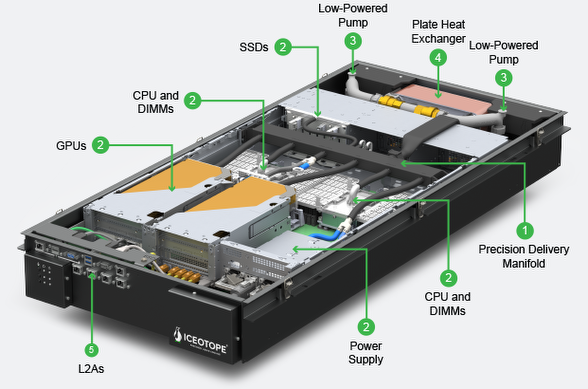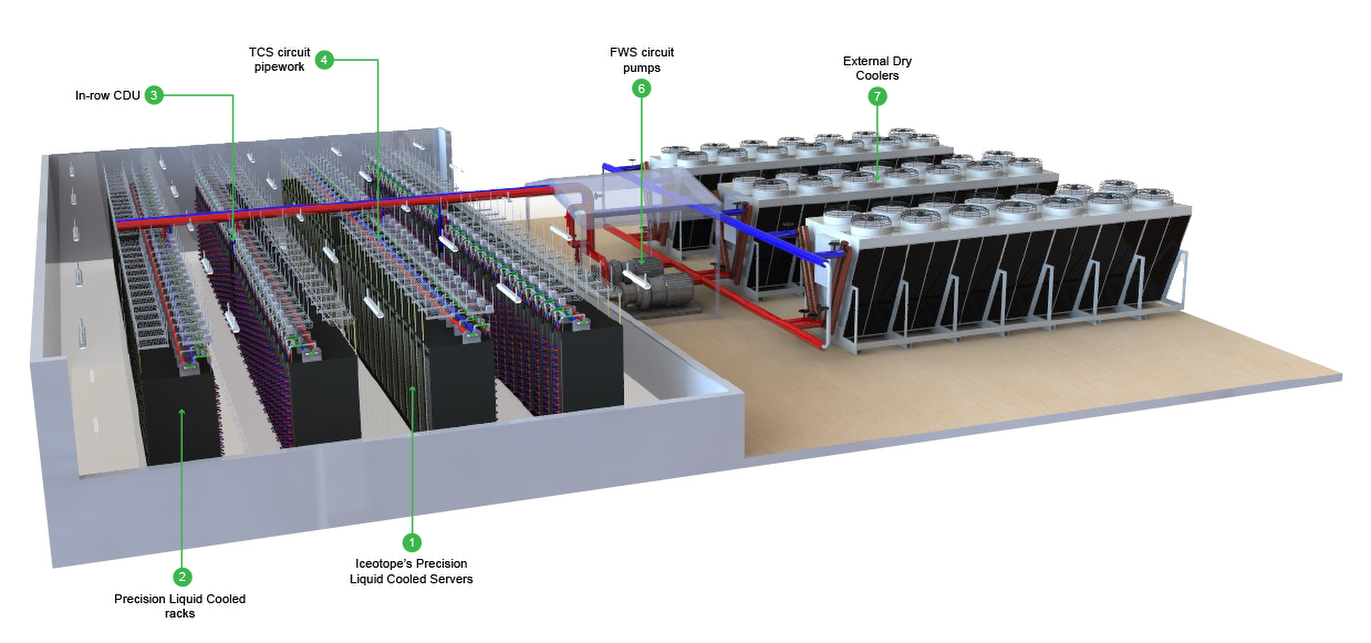A small quantity of dielectric coolant is precision delivered through an in-chassis manifold (1) to the server hotspots (2). The coolant then cascades into the chassis to capture the heat from every component.
Immersed micro pumps (3) create a gentle recirculating coolant flow inside the chassis enabling the heat to be transferred to a building circuit via a plate heat exchanger (4). Building coolant enters the heat exchanger at up to 45°C (ASHRAE W4) and exits at up to 52°C. With these high operating temperatures facilities have the opportunity to remove chillers as heat can be rejected to ambient using dry-coolers; or captured and reused for heating. Using dry-coolers means that Iceotope Liquid Cooling consumes no water.
Power in, signal out are passed through liquid-to-air connectors (5) which allows adaption from traditional air-cooled technology to Iceotope Liquid Cooled server design.

Example of a 1.6MW scheme using Iceotope Liquid Cooling

Iceotope Liquid Cooling equipment is purpose-built for data centers by focusing on a standard footprint and form factors. We integrate standard servers (1) into sealed chassis enclosures that are then densely packed into standard data center racks. The 48U racks shown above (2) can accommodate 16 chassis with each chassis capable of efficiently cooling three and a half kilowatts of IT load.
At the heart of Iceotope Liquid Cooling is a dielectric fluid that circulates within each server chassis. What sets this technology apart is that each server is precision-cooled in its own sealed chassis, enabling simple servicing and creating a safeguard against coolant contamination issues. In the rare event of a service-related incident, only one server is affected, preserving the integrity of the remaining infrastructure.
The heat generated within each server chassis is efficiently harvested and transferred to a Technology Cooling System (TCS) loop (4) via a heat exchanger positioned at the rear of each chassis. The TCS circuit is precisely managed by a Coolant Distribution Unit (CDU) (3). The CDU controls the flow rate, pressure, chemistry, and temperature of the TCS ensuring the seamless operation of the liquid cooling system.
The CDU performs an essential function by decoupling the pressure sensitive TCS circuit from the building facility circuit and enabling the TCS circuit to be a closed, low-pressure circuit. The CDU circulates the coolant fluid throughout the rack, row, and chassis, guaranteeing uniform cooling across all servers. Typically, CDUs are equipped with three pumps for N+1 redundancy, ensuring continuous and reliable cooling.
To effectively reject the captured heat into the ambient environment, Iceotope Liquid Cooling leverages dry coolers (7). The system operates at elevated temperatures, allowing the water going into the rack to reach temperatures of up to 40 degrees Celsius. High-performance servers can output water as hot as 47 degrees Celsius. This means that by the time the heat reaches the outside world, it is warmer than the surrounding ambient temperature. Consequently, there's no need to evaporate water to dissipate heat, making dry coolers a cost-effective and sustainable solution with zero water usage.
Please contact us to arrange a demo or to find out more on how Iceotope Liquid Cooling is accelerating a sustainable, digital world.